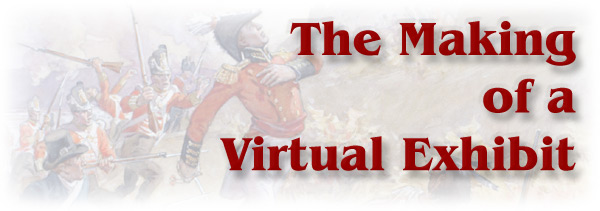
Table of Contents
Home | Setting the Stage | Battlegrounds | Militia and Civilian Life
Prisoners of War | Loyalty and Treason | The War Ends
After the War | Chronology | Soldiering in Canada
Important Figures | Important Places| Glossary
Sources | Links | The Making of a Virtual Exhibit
 |
|
|
|
| The discovery of the Plan of Fort Detroit, dated 26 January 1812 The discovery of this plan was a pure accident and came after the bulk of the research had been done, late in the development of the exhibit. The finding aid indicated the Archives of Ontario only had a copy of a plan of the fort and as a result no one thought of examining the content of the container in which the plan was stored. It was only months later, when looking to confirm the location of another document that one of the archivist-curators noticed two envelopes in this box with similar titles. |
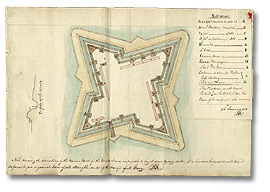 Click
to see a larger image (200K) |
| The first envelope was titled Articles of the Capitulation of Fort Detroit, Aug. 16, 1812 while the second started with the word Original. Out of curiosity, she decided to have a peek and it was at this point that the plan was located for the first time. The colours and execution of the plan drew immediate attention, but it was when trying to determine its provenance that the most fascinating aspects of this document were revealed. The date of the plan can only mean it originated from the American army as it predates the declaration of the war. At that time the Fort was in American territory. In addition to that, the emphasis put on the state of the fort in the notes led to believe this document was prepared in the anticipation of the declaration of the war by an engineer officer of the United States Army. The notes indicate that the fortifications had been inspected to determine their state of repair and readiness for war. A note left in the envelope suggests that these records would have been surrendered by U.S. General Hull to General Isaac Brock as part of the surrender of Detroit on August 16, 1812. If the authenticity of the later note is tarnished by the impossibility to determine its author or when it was written, the partial explanation to the presence of the plan in an Ontario archives remains plausible. |
|
| Bottom note – "Not knowing the dimentions [sic] of the various parts of the works, it was impossible to lay it down by any scale, it is however hoped it will be sufficient to give a general idea of its strength, and of the range of its guns." Attached note – "The platform are all new. Picketing in the ditch and on the berm of the scarp are also new." |
|
| [ Return to top
of page ] |
|
Letter from Archibald McLean, dated 15 October 1812 This letter did not include an address or a signature, so its provenance was uncertain. By examining the text it was possible to identify the likely author, Archibald McLean. The letter includes this passage:
|
|
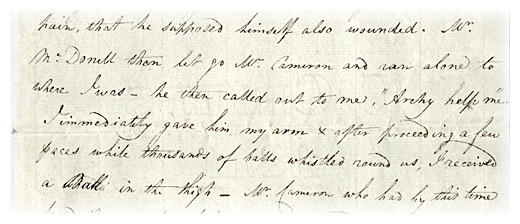 Click
here to see a larger image of the entire letter. (432K) |
|
| By examining the report on the battle submitted by General Sheaffe, it was found that the only militia officer wounded at Queenston Heights with the name "Archy" was Archibald Mclean of the York Militia. We still don't know who he wrote this to (parent, superior officer?) but identifying the author adds authenticity. |
|
| [ Return to top
of page ] |
|
The difficulties of illustrating people and place |
|
One of the challenges associated with the preparation of the exhibit on the War of 1812, was to find images of the people who lived in Upper Canada during the war. The photographic process was not invented until some years after the war ended. Moreover, very few people took the time or had the inclination to illustrate what was going on around them in wartime. To document the early part of the 19th century, we are largely dependent on the written word and the works of historical imagination, like those of C. W. Jefferys, to depict how things might have looked and felt. For example, this exhibit is using a great number of letters extracted from the Thomas Ridout family correspondence, particularly the letters from Thomas G. Ridout to his father in York and his brother George. Nowhere in the Archives of Ontario holdings could an image of Thomas G. Ridout be found. Research proved fruitless for Ely Playter, Joel Stone or Nathan Ford. Fortunately, the holdings of the Archives are rich with
documentary art from artists such
Elizabeth Simcoe,
Thomas Burrowes and the like. If not exactly
contemporary to the war, the artwork from those artists captured
the essence of what Upper Canada looked like in the early 19th
century. Their work provided to this exhibit colour and
perspective. The irony of this being that we do not have images of
either Mrs. Simcoe or Burrowes. |
|
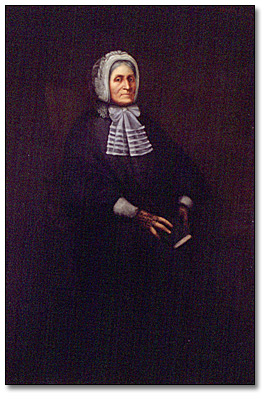 | Laura Secord died at the age of 93 on 17 October 1868. The portrait of her by Mildred Peel was executed well after her death, like those of Brock and Drummond by Berthon. An X-ray examination of the canvas revealed a portrait of Premier George Ross underneath the Secord portrait. The story made the press in 1936. Following the turmoil, the portrait of Secord, which had been displayed just outside of the Legislative Chamber since 1905, was sent to storage to be forgotten and eventually rediscovered in 1978.
Click
to see a larger image (299K)
|
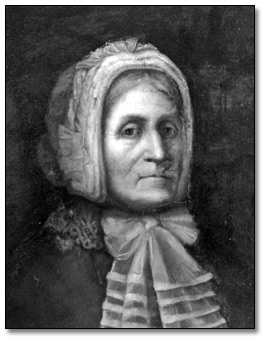 Click
to see a larger image (162K) |
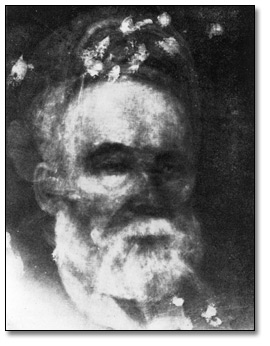 Click
to see a larger image (186K) |
|
In the x-ray image to the right the viewer can still discern the outline of Laura's bonnet and the folds in her scarf. We are indebted to Fern Bayer for her meticulous research
into the history of the Government of Ontario Art Collection. The
Ontario Collection (Toronto, Fitxhenry and Whiteside) is
the source of most of this information. |
|
| [ Return to top
of page ] |
|
 |
|
|
However, images and quotes alone usually don't suffice to make an exhibit interesting. Contextual information was needed to understand their importance or originality of the records selected. The writing, rewriting and proofing of texts is an involved process that requires feedback from experts in the field and potential audience. The final stretch before launching an exhibit related to the layout of the documents and didactic texts, which is another whole creative process in itself. From the creation of a design, a look and feel and the recording of sound bits, the objective is always to create a visually appealing exhibit conducive to the appreciation of its content. This work cannot be conducted in isolation and calls for a close collaboration between curators, designers, and webmasters. |
|
| [ Return to top
of page ] |
|
Setting the Stage | Battlegrounds | Militia and Civilian Life
Prisoners of War | Loyalty and Treason | The War Ends
After the War | Chronology | Soldiering in Canada
Important Figures | Important Places| Glossary
Sources | Links | The Making of a Virtual Exhibit
 esearch
is not always the straight forward process most people like to
imagine. There are often great surprises and disappointments.
Sometimes there are also opportunities to solve "mysteries".
Here are stories of surprises, resolved mysteries and disappointments
from the archivist-curators of the War of 1812 exhibit.
esearch
is not always the straight forward process most people like to
imagine. There are often great surprises and disappointments.
Sometimes there are also opportunities to solve "mysteries".
Here are stories of surprises, resolved mysteries and disappointments
from the archivist-curators of the War of 1812 exhibit. ith
the list of documents previously pre-selected, exhibit curators
have to determine the story line and short list the items to be
highlighted. Only those images and quotes that are crisp and fit
the focus of the exhibit will make it to the final product. Between
the selection of records and their publication on a web page, many
steps are required including conservation work, photograph of larger
or more fragile documents and digitization.
ith
the list of documents previously pre-selected, exhibit curators
have to determine the story line and short list the items to be
highlighted. Only those images and quotes that are crisp and fit
the focus of the exhibit will make it to the final product. Between
the selection of records and their publication on a web page, many
steps are required including conservation work, photograph of larger
or more fragile documents and digitization.